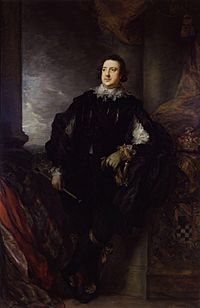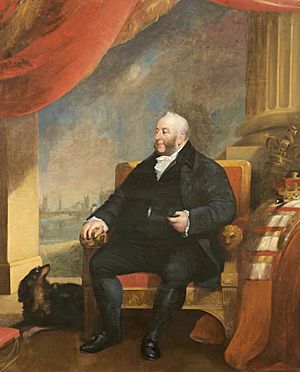Charles Howard, 11th Duke of Norfolk facts for kids
Quick facts for kids
The Duke of Norfolk
|
|
|---|---|

Painting by Thomas Gainsborough.
|
|
| Earl Marshal | |
| In office 31 August 1786 – 16 December 1815 |
|
| Monarch | George III |
| Preceded by | The 10th Duke of Norfolk |
| Succeeded by | The 12th Duke of Norfolk |
| Member of the House of Lords Lord Temporal |
|
| In office 31 August 1786 – 16 December 1815 Hereditary Peerage |
|
| Preceded by | The 10th Duke of Norfolk |
| Succeeded by | The 12th Duke of Norfolk |
| Member of Parliament | |
| In office 1780–1784 |
|
| Personal details | |
| Born | 15 March 1746 |
| Died | 16 December 1815 (aged 69) |
| Spouses | Marion Coppinger Frances Scudamore |
| Parents |
|

Charles Howard, 11th Duke of Norfolk (born March 15, 1746 – died December 16, 1815), was an important person in British society and politics. From 1777 to 1786, he was known as the Earl of Surrey. He was the son of Charles Howard, 10th Duke of Norfolk, and Catherine Brockholes.
Charles Howard was a strong supporter of King George III and was active in politics. He was part of the Tory party, which was one of the main political groups in Britain at the time. After he inherited his family's titles and lands, he spent a lot of his money on rebuilding and improving Arundel Castle, a famous historic castle.
Contents
Family Life of Charles Howard
Charles Howard married his first wife, Marion Coppinger, on August 1, 1767. Sadly, she passed away about a year later after childbirth.
He then married his second wife, Frances Scudamore, on April 6, 1771, in London, England. Frances was the only child of Charles FitzRoy-Scudamore and Frances, who was once the Duchess of Beaufort. Sadly, Frances became unwell after their marriage and lived separately until her death in 1820.
Political Career and Writings
To begin his political career, Charles Howard decided to change from Catholicism to the Church of England. However, he remained a strong supporter of Catholic Emancipation. This was a movement to give Catholics more rights in Britain. He also disagreed with the war against the American colonies.
Time in Parliament
Charles Howard was a Member of Parliament from 1780 to 1784. In 1783, he became a lord of the treasury in the government led by the Duke of Portland. This meant he helped manage the country's money.
Becoming the Duke
In 1786, after his father passed away, Charles Howard became the 11th Duke of Norfolk. This was a very important title.
Political Challenges
In 1798, he was removed from his position as Lord-Lieutenant of the West Riding. This happened because he made a toast that King George III did not like. He toasted "Our sovereign’s health—the majesty of the people," which suggested that the power of the people was more important than the King's power.
His Writings and Friendships
Norfolk wrote a book called Historical Anecdotes of some of the Howard Family. It was published in 1769 and again in 1817. He was also a good friend of Sir Bysshe Shelley, 1st Baronet. In 1786, Norfolk helped Shelley get his baronetcy, which is a special title. Shelley was inspired by Norfolk and built a grand house called Castle Goring. One side of this house looked like a part of Arundel Castle, where Norfolk lived.
Later Life and Legacy
Charles Howard passed away on December 16, 1815, when he was 69 years old. He did not have any children from his two legal marriages. After his death, his lands and titles went to his cousin, Bernard.
He was known for enjoying good food and drink. It was also said that he didn't like to wash very often!
Family tree
| Earls of Norfolk and Dukes of Norfolk | |||||||||||||||||||||||||||||||||||||||||||||||||||||||||||||||||||||||||||||||||||||||||||||||||||||||||||||||||||||||||||||||||||||||||||||||||||||||||||||||||||||||||||||||||||||||||||||||||||||||||||||||||||||||||||||||||||||||||||||||||||||||||||||||||||||||||||||||||||||||||||||||||||||||||||||||||||||||||||||||||||||||||||||||||||||||||||||||||||||||||||||||||||||||||||||||||||||||||||||||||||||||||||||||||||||||||||||||||||||||||||||||||||||||||||||||||||||||||||||||||||||||||||||||||||||||||||||||||||||||||||||||||||||||||||||||||||||||||||||||||||||||||||||||||||||||||||||||||||||||||||||||||||||||||||||||||||||||||||||||||||||||||||||||||||||||||||||||||||||||||||||||||||||||||||||||||||||||||||||||||||||||||||||||||||||||||||||||||||||||||||||||||||||||||||||||||||||||||||||||||||||||||||||||||||||||||||||||||||||||||||||||||||||||||||||||||||||||||||||||||||||||||||||||||||||||||||||||||||||||||||||||||||||||||||||||||||||||||||||||||||||||||||||||||||||||||||||||||||||||
|---|---|---|---|---|---|---|---|---|---|---|---|---|---|---|---|---|---|---|---|---|---|---|---|---|---|---|---|---|---|---|---|---|---|---|---|---|---|---|---|---|---|---|---|---|---|---|---|---|---|---|---|---|---|---|---|---|---|---|---|---|---|---|---|---|---|---|---|---|---|---|---|---|---|---|---|---|---|---|---|---|---|---|---|---|---|---|---|---|---|---|---|---|---|---|---|---|---|---|---|---|---|---|---|---|---|---|---|---|---|---|---|---|---|---|---|---|---|---|---|---|---|---|---|---|---|---|---|---|---|---|---|---|---|---|---|---|---|---|---|---|---|---|---|---|---|---|---|---|---|---|---|---|---|---|---|---|---|---|---|---|---|---|---|---|---|---|---|---|---|---|---|---|---|---|---|---|---|---|---|---|---|---|---|---|---|---|---|---|---|---|---|---|---|---|---|---|---|---|---|---|---|---|---|---|---|---|---|---|---|---|---|---|---|---|---|---|---|---|---|---|---|---|---|---|---|---|---|---|---|---|---|---|---|---|---|---|---|---|---|---|---|---|---|---|---|---|---|---|---|---|---|---|---|---|---|---|---|---|---|---|---|---|---|---|---|---|---|---|---|---|---|---|---|---|---|---|---|---|---|---|---|---|---|---|---|---|---|---|---|---|---|---|---|---|---|---|---|---|---|---|---|---|---|---|---|---|---|---|---|---|---|---|---|---|---|---|---|---|---|---|---|---|---|---|---|---|---|---|---|---|---|---|---|---|---|---|---|---|---|---|---|---|---|---|---|---|---|---|---|---|---|---|---|---|---|---|---|---|---|---|---|---|---|---|---|---|---|---|---|---|---|---|---|---|---|---|---|---|---|---|---|---|---|---|---|---|---|---|---|---|---|---|---|---|---|---|---|---|---|---|---|---|---|---|---|---|---|---|---|---|---|---|---|---|---|---|---|---|---|---|---|---|---|---|---|---|---|---|---|---|---|---|---|---|---|---|---|---|---|---|---|---|---|---|---|---|---|---|---|---|---|---|---|---|---|---|---|---|---|---|---|---|---|---|---|---|---|---|---|---|---|---|---|---|---|---|---|---|---|---|---|---|---|---|---|---|---|---|---|---|---|---|---|---|---|---|---|---|---|---|---|---|---|---|---|---|---|---|---|---|---|---|---|---|---|---|---|---|---|---|---|---|---|---|---|---|---|---|---|---|---|---|---|---|---|---|---|---|---|---|---|---|---|---|---|---|---|---|---|---|---|---|---|---|---|---|---|---|---|---|---|---|---|---|---|---|---|---|---|---|---|---|---|---|---|---|---|---|---|---|---|---|---|---|---|---|---|---|---|---|---|---|---|---|---|---|---|---|---|---|---|---|---|---|---|---|---|---|---|---|---|---|---|---|---|---|---|---|---|---|---|---|---|---|---|---|---|---|---|---|---|---|---|---|---|---|---|---|---|---|---|---|---|---|---|---|---|---|---|---|---|---|---|---|---|---|---|---|---|---|---|---|---|---|---|---|---|---|---|---|---|---|---|---|---|---|---|---|---|---|---|---|---|---|---|---|---|---|---|---|---|---|---|---|---|---|---|---|---|---|---|---|---|---|---|---|---|---|---|---|---|---|---|---|---|---|---|---|---|---|---|---|---|---|---|---|---|---|---|---|---|---|---|---|---|---|---|---|---|---|---|---|---|---|---|---|---|---|---|---|---|---|---|---|---|---|---|---|---|---|---|---|---|---|---|---|---|---|---|---|---|---|---|---|---|---|---|---|---|---|---|---|---|---|---|---|---|---|---|---|---|---|---|---|---|---|---|---|---|---|---|---|---|---|---|---|---|---|---|---|---|---|---|---|---|---|---|---|---|---|---|---|---|---|---|---|---|---|---|---|---|---|---|---|---|---|---|---|---|---|---|---|---|---|---|---|---|---|---|---|---|---|---|---|---|---|---|---|---|---|---|---|---|---|---|---|---|---|---|---|---|---|---|---|---|---|---|---|---|---|---|---|---|---|---|---|---|---|---|---|---|---|---|---|---|---|---|---|---|---|---|---|---|---|---|---|---|---|---|---|---|---|---|---|---|---|---|---|---|---|---|---|---|---|---|---|---|---|---|---|---|---|---|---|---|---|---|---|---|---|---|---|---|---|---|---|---|---|---|---|---|---|---|---|---|---|---|---|---|---|---|---|---|---|---|---|---|---|---|---|---|---|---|---|---|---|---|---|---|---|---|---|---|---|---|---|---|---|---|---|---|---|---|---|---|---|---|---|---|
|
|||||||||||||||||||||||||||||||||||||||||||||||||||||||||||||||||||||||||||||||||||||||||||||||||||||||||||||||||||||||||||||||||||||||||||||||||||||||||||||||||||||||||||||||||||||||||||||||||||||||||||||||||||||||||||||||||||||||||||||||||||||||||||||||||||||||||||||||||||||||||||||||||||||||||||||||||||||||||||||||||||||||||||||||||||||||||||||||||||||||||||||||||||||||||||||||||||||||||||||||||||||||||||||||||||||||||||||||||||||||||||||||||||||||||||||||||||||||||||||||||||||||||||||||||||||||||||||||||||||||||||||||||||||||||||||||||||||||||||||||||||||||||||||||||||||||||||||||||||||||||||||||||||||||||||||||||||||||||||||||||||||||||||||||||||||||||||||||||||||||||||||||||||||||||||||||||||||||||||||||||||||||||||||||||||||||||||||||||||||||||||||||||||||||||||||||||||||||||||||||||||||||||||||||||||||||||||||||||||||||||||||||||||||||||||||||||||||||||||||||||||||||||||||||||||||||||||||||||||||||||||||||||||||||||||||||||||||||||||||||||||||||||||||||||||||||||||||||||||||||

